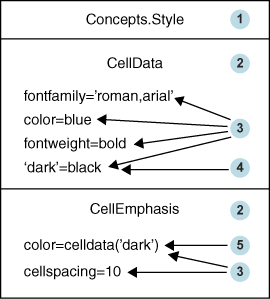Understanding Styles, Style Elements, and Style Attributes
Overview
To customize the output at the level of
your entire output stream in a SAS session, you specify a style.
A style describes how to generate the presentation aspects (color,
font face, font size, and so on) of the entire SAS output. A style
determines the overall look of the documents that use it.
Each style consists of style elements.
A style element is a collection of style attributes that apply to
a particular part of the output. For example, a style element might
contain instructions for the presentation of column headings, or for
the presentation of the data inside the cells. Style elements might
also specify default colors and fonts for output that uses the style.
Each style attribute specifies
a value for one aspect of the presentation. For example, the BACKGROUND=
attribute specifies the color for the background of an HTML table
or for a colored table in printed output. The FONTSTYLE= attribute
specifies whether to use a Roman or an italic font. For information about style attributes, see the section
on style attributes in TEMPLATE Procedure: Creating a Style Template.
Using the Template Browser Window
To help you become familiar
with styles, style elements, and style attributes, look at the relationship
between them. The following program creates a style, Concepts.Style.
The diagram that follows the program shows the relationship between
the style, the style elements, and the style attributes.
proc template;
define style concepts.style;
style celldata /
fontfamily="roman, arial"
color=blue
fontweight =bold
"dark"=black;
style cellemphasis from celldata /
color=celldata("dark")
borderspacing=10;
end;
run; Diagram of a Style, Including Style Elements and Style Attributes

The following list corresponds to the numbered items in the
preceding diagram:
| 1 | Concepts.Style is a style. Styles describe how to display presentation aspects (color, font, font size, and so on) of the output for an entire SAS job. A style determines the overall appearance of the ODS documents that use it. Each style consists of style elements. Styles are created with the DEFINE STYLE Statement. New styles can be created independently or from an existing style. You can use the PARENT= Statement to create a new style from an existing style. |
| 2 | CellData
and CellEmphasis are style elements. A style
element is a collection of style attributes that apply to a particular
part of the output for a SAS program. For example, a style element
might contain instructions for the presentation of column headings
or for the presentation of the data inside table cells. Style elements
might also specify default colors and fonts for output that uses the
style. Style elements exist inside of styles and are defined by the STYLE Statement.
Note: For a list of the default
style elements used for HTML and markup languages and their inheritance,
see ODS Style Elements.
|
| 3 | The
following are style attribute-value pairs:
blue for the foreground color
of a table, and the FONTFAMILY= attribute specifies the values roman and arial as
the font to use. Style attributes exist within style elements and
can be supplied by SAS or be user-defined. FONTFAMILY=, COLOR=, FONTWEIGHT=,
and BORDERSPACING= are style attributes supplied by SAS. For a list
of style attributes supplied by SAS, see Style Attributes Tables . |
| 4 | "Dark"
is a user-defined style attribute. It specifies
to substitute the value black whenever
the value "dark" is specified.
|
| 5 | The
value celldata("dark") is a style
reference. Style attributes can be referenced with style
references. This style reference specifies that PROC TEMPLATE go to
the CellData style element and use the value that is specified for
the "dark" style attribute. See style-reference for more information about style references.
|
You can view the style
elements and style attributes in any style from the Template
Browser window in the SAS windowing environment. To view
the Template Browser:
Styles That Are Shipped with SAS Software
Base SAS software is shipped with many styles. To see
a list of these styles, view them in the SAS Explorer Window, use
the TEMPLATE procedure, or use the SQL procedure.
For more
information about how ODS destinations use styles and how you can
customize styles, see the DEFINE STYLE Statement.
Using Styles with Base SAS Procedures
-
Most Base SAS procedures that support ODS use one or more table templates to produce output objects. These table templates include templates for table elements: columns, headers, and footers. Each table element can specify the use of one or more style elements for various parts of the output. These style elements cannot be specified within the syntax of the procedure, but you can use customized styles for the ODS destinations that you use. For more information about customizing tables and styles, see TEMPLATE Procedure: Creating a Style Template.
-
The PRINT, REPORT, and TABULATE procedures provide a way for you to access table elements from the procedure step itself. Accessing the table elements enables you to do such things as specify background colors for specific cells, change the font face for column headings, and more. The PRINT, REPORT, and TABULATE procedures provide a way for you to customize the markup language and printed output directly from the procedure statements that create the report. For more information about customizing the styles for these procedures, see the Base SAS Procedures Guide.
